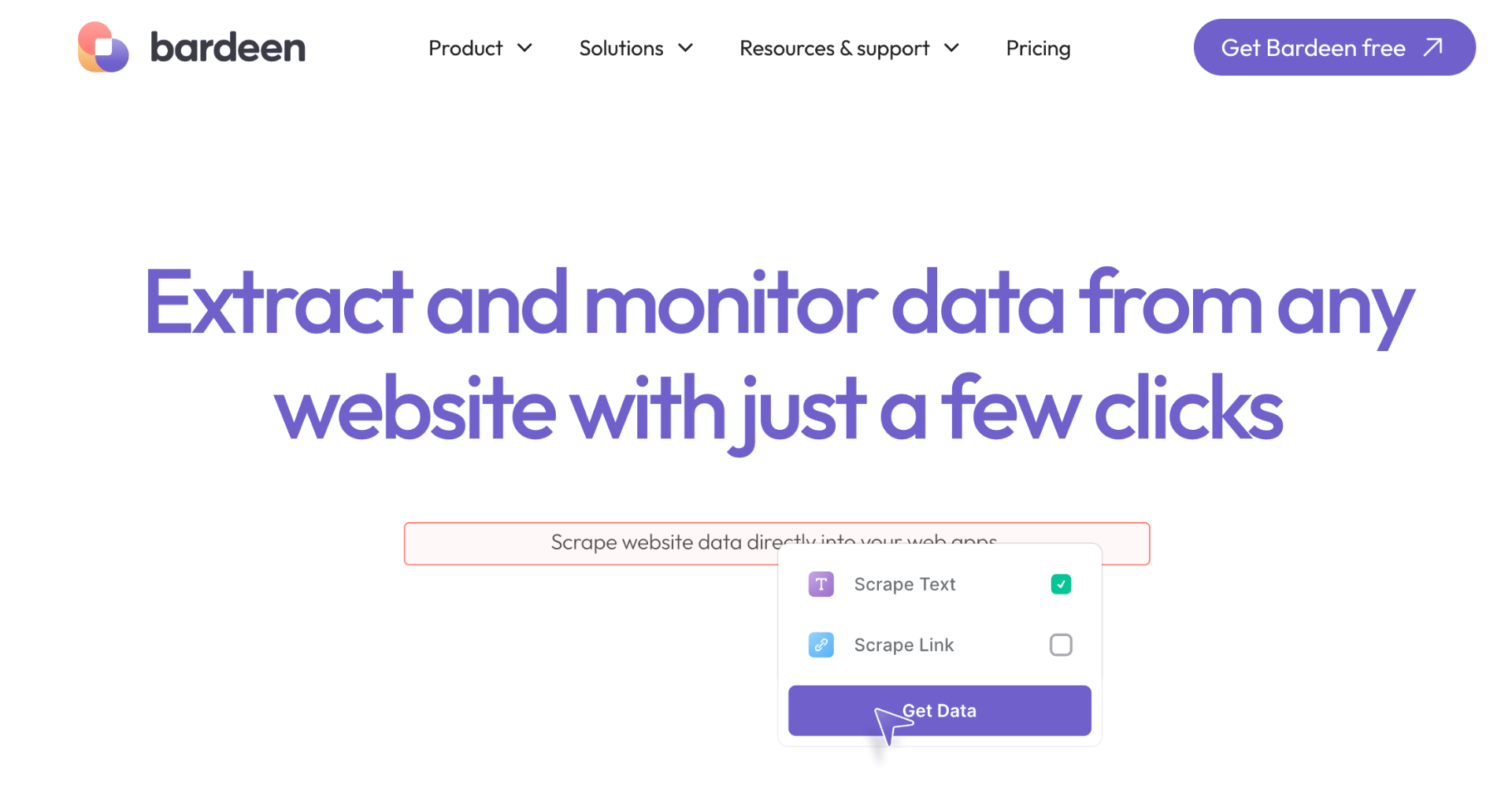Scrape LinkedIn Profiles with Selenium in 8 Steps

TL;DR
Scraping LinkedIn with Selenium involves automating login, navigating profiles or search results, and extracting data using Python. This process requires installing Selenium, ChromeDriver, and other libraries, followed by writing Python code to navigate and extract data from LinkedIn. The extracted data can then be saved for analysis.
Adhering to LinkedIn's terms and ethical guidelines is crucial to avoid legal issues.
For a more streamlined approach to scraping LinkedIn, automate your lead generation and market research tasks with Bardeen.
Scraping LinkedIn profiles and data can be a powerful way to gather valuable insights for business, research, or personal projects. In this step-by-step guide, we'll walk you through the process of using Python and Selenium to automate LinkedIn scraping tasks. We'll cover setting up your environment, logging into LinkedIn, navigating profiles, extracting specific data points, and handling important ethical considerations along the way.
Setting Up Your Environment for LinkedIn Scraping
Before diving into scraping LinkedIn profiles and data with Selenium and Python, it's crucial to set up your environment properly. Here are the key steps:
- Install Python: Make sure you have Python installed on your system. You can download the latest version from the official Python website (https://www.python.org/downloads/).
- Set up Selenium: Install the Selenium library for Python by running the following command in your terminal or command prompt:
pip install selenium - Download WebDriver: Selenium requires a WebDriver to interact with the browser. For Chrome, you'll need the ChromeDriver. Download it from the official website (https://sites.google.com/a/chromium.org/chromedriver/downloads) and ensure that the version matches your installed Chrome browser version.
Once you have Python, Selenium, and the WebDriver set up, you're ready to start automating LinkedIn profile extraction with your scraping script.
.png)
Writing a Selenium Script to Log Into LinkedIn
To automate logging into your LinkedIn account using Selenium and Python, follow these steps:
- Import the necessary libraries:
from selenium import webdriver from selenium.webdriver.common.by import By- Create an instance of the Chrome WebDriver:
driver = webdriver.Chrome("path/to/chromedriver") - Navigate to the LinkedIn login page:
driver.get("https://www.linkedin.com/login") - Locate the username and password input fields using XPath:
username = driver.find_element(By.XPATH, "//input[@name='session_key']") password = driver.find_element(By.XPATH, "//input[@name='session_password']")- Enter your LinkedIn credentials:
username.send_keys("your_username") password.send_keys("your_password")- Click the login button:
login_button = driver.find_element(By.XPATH, "//button[@type='submit']") login_button.click()
After executing this script, Selenium will automatically log into your LinkedIn account, and you'll be ready to extract data from LinkedIn profiles and scrape data from the site. To further automate your LinkedIn scraping workflows, consider using Bardeen's LinkedIn scraper which helps you easily extract profile, company, or search result data at scale.
Want to save time and avoid repetitive scraping tasks? Use Bardeen's playbook to automate LinkedIn data extraction with just one click.
Navigating LinkedIn and Accessing Profile Data
Once you've successfully logged into LinkedIn using Selenium, you can navigate to various sections of the site and access profile data. Here's how:
- To navigate to a specific user's profile, use the following command:
driver.get("https://www.linkedin.com/in/username") - Replace "username" with the actual profile URL or username of the person you want to scrape using automation.
- To access a company page, use a similar command with the company's LinkedIn URL:
driver.get("https://www.linkedin.com/company/company-name") - LinkedIn loads content dynamically as you scroll. To ensure all data is loaded, use Selenium's
execute_script()method to scroll the page:driver.execute_script("window.scrollTo(0, document.body.scrollHeight);") - This scrolls to the bottom of the page, triggering LinkedIn to load more content.
- Some data may be hidden behind tabs or expandable sections. To access this data, first locate the tab or button element using XPath or CSS selectors, then use the
click()method to interact with it:button = driver.find_element(By.XPATH, "//button[@class='see-more-button']") button.click()- This example clicks a "See more" button to reveal additional content.
By using these navigation techniques, you can access various sections of LinkedIn profiles and company pages, ensuring that all relevant data is loaded and ready for extraction to spreadsheets or databases.
Extracting Specific Data from LinkedIn Profiles
Once you've navigated to a LinkedIn profile using Selenium, you can extract specific data points by leveraging libraries like BeautifulSoup or Parsel. Here's how:
.png)
- First, get the page source of the profile using Selenium:
profile_html=driver.page_source - Then, create a BeautifulSoup object with the page source:
soup=BeautifulSoup(profile_html,'html.parser') - To extract the name, use the following CSS selector:
name=soup.select_one('h1.text-heading-xlarge').text.strip() - This finds the first
h1element with the classtext-heading-xlargeand extracts profile data. - For the job title, use a similar approach:
title=soup.select_one('div.text-body-medium').text.strip() - To extract contact details like email or phone number, you might need to look for specific elements or attributes. For example:
email=soup.select_one('a[href^="mailto:"]')['href'].replace('mailto:','') - This finds an
aelement with anhrefattribute starting with "mailto:" and extracts the email address.
Here are some more examples of XPath and CSS selectors for common LinkedIn profile data points:
- Company:
soup.select_one('ul.pv-top-card--experience-list li').text.strip() - Education:
soup.select_one('ul.pv-top-card--education-list li').text.strip() - Location:
soup.select_one('span.text-body-small.inline.t-black--light.break-words').text.strip()
By using these techniques and adapting the selectors to the specific LinkedIn profile structure, you can extract various data points and store them for further analysis or processing.
Want to save time and avoid repetitive scraping tasks? Use Bardeen's playbook to automate LinkedIn data extraction with just one click.
.png)
Handling Data Extraction Ethics and LinkedIn's Policies
When scraping data from LinkedIn, it's crucial to consider the ethical implications and adhere to LinkedIn's policies. Here are some key points to keep in mind:
- LinkedIn's User Agreement explicitly prohibits the use of automation tools for data scraping without their permission.
- Respect LinkedIn's robots.txt file, which specifies the rules for web crawlers and scrapers. Violating these guidelines can result in account bans or legal consequences.
- Practice responsible scraping by limiting your request rate to avoid overloading LinkedIn's servers. Implement delays between requests to mimic human behavior and prevent detection.
- Be transparent about your identity and intentions when scraping data. Provide a clear User-Agent string that includes your contact information.
- Use scraped data ethically and responsibly. Avoid scraping sensitive personal information or using the data for spamming or malicious purposes.
To minimize the risk of account bans or legal issues, consider the following best practices:
- Use LinkedIn's official APIs whenever possible to access data in a sanctioned manner.
- Limit your scraping activity to a reasonable volume, such as scraping no more than 50 profiles per day.
- Implement proxy servers or rotate IP addresses to distribute your requests and avoid detection.
- Regularly monitor LinkedIn's terms of service and adjust your scraping practices accordingly.
Remember, while web scraping itself is not illegal, violating LinkedIn's terms of service can lead to consequences. Strike a balance between extracting valuable data and respecting the platform's policies to ensure a sustainable and ethical scraping process.
Simplify LinkedIn Data Scraping with Bardeen Automation
While the manual process of scraping LinkedIn with Selenium provides a detailed and technical approach, Bardeen offers a simplified and efficient automation alternative. Automating data extraction from LinkedIn can save countless hours, especially for tasks like lead generation, market research, and competitive analysis. For those looking to streamline their LinkedIn data scraping efforts, Bardeen's playbooks are a game-changer.
Here are some examples of how Bardeen can automate LinkedIn data scraping:
- Get data from a LinkedIn profile search: Automate the extraction of data from LinkedIn profile searches seamlessly, ideal for sourcing leads or gathering insights.
- Scrape Company Headcount from LinkedIn Profile: Extract company headcount information directly from a LinkedIn profile, useful for market research and competitive analysis.
- Qualify LinkedIn Companies and Save to Salesforce: Streamline lead qualification by scraping LinkedIn company data and saving it directly to Salesforce.
Discover the power of automation by downloading the Bardeen app at Bardeen.ai/download
Explore top sales prospecting strategies and tips to identify potential customers and grow your business in 2024.
Learn to scrape LinkedIn data using Python, covering setup, libraries like Selenium, Beautiful Soup, and navigating LinkedIn's dynamic content.
Learn how to scrape LinkedIn data using R with web scraping techniques or the LinkedIn API, including steps, packages, and compliance considerations.
Learn how to scrape LinkedIn data using React, Python, and specialized tools. Discover the best practices for efficient data extraction while complying with legal requirements.
Learn to scrape LinkedIn using Beautiful Soup and Python for data analysis, lead generation, or job automation, while adhering to LinkedIn's terms of service.
Looking to download your own or another's LinkedIn profile picture? Discover how LinkedIn photo download can be easily done, with privacy top of mind.
Your proactive teammate — doing the busywork to save you time
.svg)
Integrate your apps and websites
Use data and events in one app to automate another. Bardeen supports an increasing library of powerful integrations.
.svg)
Perform tasks & actions
Bardeen completes tasks in apps and websites you use for work, so you don't have to - filling forms, sending messages, or even crafting detailed reports.
.svg)
Combine it all to create workflows
Workflows are a series of actions triggered by you or a change in a connected app. They automate repetitive tasks you normally perform manually - saving you time.
Don't just connect your apps, automate them.
200,000+ users and counting use Bardeen to eliminate repetitive tasks







